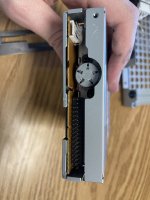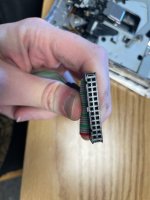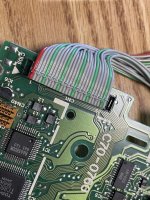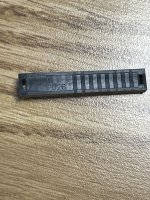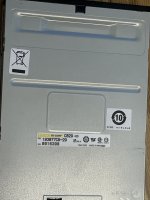TheGrungler
New Member
- Joined
- Jan 4, 2025
- Messages
- 8
Greetings, Internet denizens!
I found a t3100e on ebay recently that was advertised to turn on and boot into BIOS. After I purchased it, I realized this was true (at least while the switch on the right side was on PRT).
In an attempt to justify the choices I've made so far, let it be known that I tried (and failed) to use chatgpt to walk me through the installation and troubleshooting. I have learned that this is sub-optimal. The first half of this post documents what I did and the second half is where I am now.
I'm trying to get an OS running on it. I'm looking at FreeDOS [ https://www.freedos.org/download/ ], specifically the floppy only edition. The full version seems to be too large for me, as uncompressed it is larger than my 40-or-80 MB hard drive(s) on my t3100e.
I ordered a disk reader off ebay, it broke within 15 minutes, I pulled out my old disk reader from storage, which seems to work fine. I can see the floppy drive A: in file explorer. It takes about 30 seconds to open the folder, which I assume is just because it's old and not as fast as my hypersonic-speed 2016 Seagate HDD. I read this as "this drive is gonna be fine". I tried to format it via the command line, Rufus, WinImage, and rawwrite. Only rawwrite seemed to work. Rufus wouldn't detect my USB disk drive even with the advanced setting on that specifically told it to check USB drives. WinImage worked for some drives, but not others. (For reference, I tried 3-4 disks with the first drive before it broke, and it didn't work for any of them, always something about Head 44 Section 0 not available, or something along those lines).
Somehow or another, I got rawwrite to say it finished writing the x86BOOT image to my floppy. I then opened the port on the drive (it no longer appeared in file explorer) and plugged it into my laptop.
I was greeted with the CMOS battery failure screen as shown in the manual [ https://www.minuszerodegrees.net/manuals/Toshiba/Other/Toshiba T3100e - Maintenance Manual.pdf ] (page 24 of the pdf). I assumed this was fine and I pressed f1 to go into BIOS (my switch is still on PRT at this point). After exiting BIOS on default settings, it ran its standard memory test and then printed "ERROR INITIALIZING HARD DISK CONTROLLER". If I sit on this and wait long enough I am prompted with "insert system disk in drive / press any key when ready..."
At this point, I do, and here is where my knowledge ends. It starts printing `.Error!` repeatedly until I power off.
The question I have for you all is:
What went wrong, and how do I fix it? I'm a complete noob when it comes to this stuff, and I picked this computer out because of the pretty display and because it was on the cheaper end. If there are any better resources for information than the manual (or if the manual does in fact solve my problems, and I just can't read), where can I find them?
Thank you all! I will attach images if necessary, but I'm on my phone right now, so I won't include any in the original post.
I found a t3100e on ebay recently that was advertised to turn on and boot into BIOS. After I purchased it, I realized this was true (at least while the switch on the right side was on PRT).
In an attempt to justify the choices I've made so far, let it be known that I tried (and failed) to use chatgpt to walk me through the installation and troubleshooting. I have learned that this is sub-optimal. The first half of this post documents what I did and the second half is where I am now.
I'm trying to get an OS running on it. I'm looking at FreeDOS [ https://www.freedos.org/download/ ], specifically the floppy only edition. The full version seems to be too large for me, as uncompressed it is larger than my 40-or-80 MB hard drive(s) on my t3100e.
I ordered a disk reader off ebay, it broke within 15 minutes, I pulled out my old disk reader from storage, which seems to work fine. I can see the floppy drive A: in file explorer. It takes about 30 seconds to open the folder, which I assume is just because it's old and not as fast as my hypersonic-speed 2016 Seagate HDD. I read this as "this drive is gonna be fine". I tried to format it via the command line, Rufus, WinImage, and rawwrite. Only rawwrite seemed to work. Rufus wouldn't detect my USB disk drive even with the advanced setting on that specifically told it to check USB drives. WinImage worked for some drives, but not others. (For reference, I tried 3-4 disks with the first drive before it broke, and it didn't work for any of them, always something about Head 44 Section 0 not available, or something along those lines).
Somehow or another, I got rawwrite to say it finished writing the x86BOOT image to my floppy. I then opened the port on the drive (it no longer appeared in file explorer) and plugged it into my laptop.
I was greeted with the CMOS battery failure screen as shown in the manual [ https://www.minuszerodegrees.net/manuals/Toshiba/Other/Toshiba T3100e - Maintenance Manual.pdf ] (page 24 of the pdf). I assumed this was fine and I pressed f1 to go into BIOS (my switch is still on PRT at this point). After exiting BIOS on default settings, it ran its standard memory test and then printed "ERROR INITIALIZING HARD DISK CONTROLLER". If I sit on this and wait long enough I am prompted with "insert system disk in drive / press any key when ready..."
At this point, I do, and here is where my knowledge ends. It starts printing `.Error!` repeatedly until I power off.
The question I have for you all is:
What went wrong, and how do I fix it? I'm a complete noob when it comes to this stuff, and I picked this computer out because of the pretty display and because it was on the cheaper end. If there are any better resources for information than the manual (or if the manual does in fact solve my problems, and I just can't read), where can I find them?
Thank you all! I will attach images if necessary, but I'm on my phone right now, so I won't include any in the original post.



